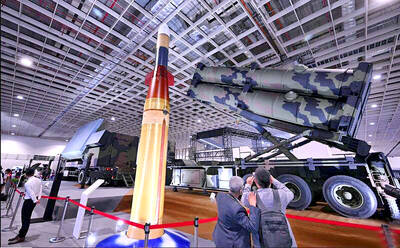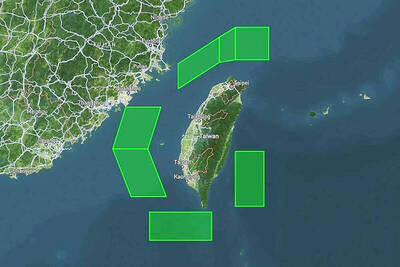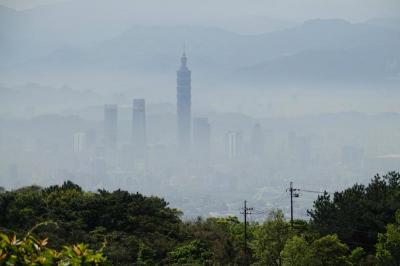Liberty Times: You once said that the nation would be burdened with chronic water problems, including “floods when it rains, and droughts when it does not.” With the nation facing perhaps its worst water shortage in decades, what are your thoughts as to the reasons? Does Taiwan inherently lack water supplies, or is it failing to retain them?
Hwung Hwung-hweng (黃煌煇): In research by the 2013 World Economic Forum on factors affecting the world economy the most, water resources were listed as the second-highest factor. In this year’s survey, they have become No. 1. The lack and mismanagement of water resources heavily affects the global economy, and Taiwan’s situation is a reflection of this situation.
Taiwan’s average annual rainfall is 2,500mm. The problem is that we cannot retain the water.
Taiwan’s annual rainfall is [almost] three times the world average of 900mm, and is the second-highest in the world, with more than 90 billion tonnes per year. However, we only have 18.5 billion tonnes to use the year over, which puts the average water supply available per person at 3,950 cubic meters, far less than the global standard of 32,000 cubic meters per person. Taiwan is in 18th place in UN global rankings in terms of being a “water-resource-poor region,” and second-to-last in terms of available water sources.
More than 80 percent of the rainwater that falls on Taiwan is lost, with 50 billion tonnes per year flowing out to the sea. What is retained is often insufficient to cover domestic use, leading the nation to draw more than 5 billion tonnes from underground water sources. Such a situation means Taiwan is not only constantly lacking water, it are also causing another sort of environmental destruction.
LT: Are the frequency of floods and water shortages increasing?
Hwung: The changes in climate have caused rain to fall over a shorter period. In the Taipei area, rainy days have decreased by 28 days per year over the past two decades, but the volume of rain per day has increased, even exceeding the amount of water displacement the city is able to handle, leading to flooding.
The majority of rain in Taiwan, about 70 to 90 percent, is concentrated in the summer, and the island is reliant on the plum rain season — as well as typhoons — to bring in water. However, the number of typhoons making landfall has decreased, and those that have made landfall have brought less precipitation.
Moreover, our reservoirs are clogged with sediment and their capacity for water storage is declining.
Under such circumstances, the frequency of water shortages is naturally increasing.
Previous administrations never really made water resource management a focus of their policies.
They forgot the pain of water shortages as soon as the rains ameliorated the situation. It is evident that the government has not paid any attention to or made any effort to implement water management.
This shortsighted attitude of relying on nature will not help the nation retain its water.
LT: Sediment clogging reservoirs is a normal occurrence, but it seems the government’s efforts — the NT$5 billion (US$158.86 million) devoted to removing sediment after Typhoon Morakot and the NT$60 billion five-year project — have not had any effect. What do you think?
Hwung: The 46 major reservoirs were originally designed to have a total capacity of 43 billion tonnes. However, due to the severity of sediment deposits, we can only store 22 billion tonnes, not even half the designed capacity. The amount of stored water simply cannot keep up with the annual nationwide use of 10 billion tonnes.
The government has committed a large amount of money to remove the sediment by various methods: sand pumpers, building check dams to clear out other portions of the reservoirs, and trucking sediment elsewhere.
According to the Water Resources Agency, clearing 1m3 of sediment costs the government NT$300, although the price has risen to NT$600 recently. That means it costs NT$6 billion just to clear 10 million cubic meters of sediment.
Typhoon Morakot alone brought more than 10 billion cubic meters of dirt and sand into the reservoirs. With 2.8 million tonnes to 4 million tonnes of sediment being cleared out of the reservoirs per year, the nation simply cannot keep up with the amount of buildup.
The current amount of sediment in the Zengwen Reservoir (曾文水庫) would take perhaps a century to remove.
In short, trying to clear sediment from the reservoirs is like throwing money into a fire.
LT: Is there a faster way of removing the sediment?
Hwung: Sediment is carried downriver from upstream and then into the oceans; it is a natural process, which we can use to our advantage. We could use a simple physics concept, such as siphoning, by installing a pipeline and using the difference in height between a check dam and a spillway to drain sediment from the bottom of a reservoir after using small boats to stir up the water and sediment in the reservoir.
This method is especially useful during periods of high water levels, as we would be using the natural flow of rivers to rid us of the sediment. Moreover, it would barely cost the government 1 percent of its current costs.
Other have told the government before that sediment-clearing projects have led to the formation of a huge number of profiteering companies and that offering a cheaper alternative can lead to physical dangers. Despite the risk, I still call on the government to recognize that hydraulic engineering is not difficult; the difficulty lies in whether the government has the resolve to use it.
LT: Some academics placed the blame for water waste in Taiwan to the low price of water. What are your thoughts on this?
Hwung: In Taiwan, individual water use per day averages 280 liters. In comparison, the average per person use of water per day in Japan is 190 liters. They also recycle more than 90 percent of the water used by industry, while water recycling in Taiwan lags far behind.
The price for tap water in Taiwan is NT$10.8 per cubic meter, which is one-fourth of Singapore’s water price and one-seventh of Japan’s, which make it quite unreasonable.
The average annual water bill per family in Taiwan over the past five years stands at NT$3,774, while the average annual family income is NT$1.47 million, meaning the water bill barely takes up 0.26 percent of the average income.
Industrial water use, with its discounted prices, is even lower. The Taiwanese industrial sector makes NT$1.36 trillion per year and uses an average of 680 million cubic meters per year, while paying 0.054 percent of its income, or NT$7.3 billion, for water.
Faced with a shortage of water, the government must consider using prices to control water consumption and boost the amount of industrial water recycling.
Tap-water prices have basically remained unchanged for nearly two decades. The law demands that water prices should see a profit from at least 5 percent to 9 percent, while the current profit margin is 0.03 percent and even dipped into the red, at negative 0.15 percent from 2000 to 2010.
There are leaks in 22 percent of water pipelines, far higher than the US’ 14 percent and Japan’s 7 percent. The total amount of water lost annually through pipeline leaks is about twice the capacity of the Feitsui Reservoir (翡翠水庫).
The Taiwan Water Corp has already borrowed NT$45 billion, but is unable to replace aging pipelines. It would cost about NT$500 billion to replace 5,000km of pipes.
Without increasing water prices, we are not able to shoulder the costs of such a project.
LT: What advice would you give the government about ameliorating the water problem?
Hwung: The lack of water in reservoirs could cause not only social unrest, but could heavily impact the nation’s economy. Some people have even said the situation is a national security issue.
Under such circumstances, water resource management should be moved to a higher level of government than the Water Resources Agency.
The National Development Council should be tasked with the management and planning of water resources. The government can no longer continue with the hands-off attitude it has adopted.
As for the distribution of water, the local water resource associations across the nation hold more than 70 percent of distribution rights, leaving just 30 percent of water to be used for urban and industrial areas.
However, according to the Council of Agriculture, agricultural use nationwide has been placed at just 50 percent.
The local water resource associations’ monopoly on water means that industries that need water are buying it at a higher price. Water might cost NT$4 per kilogram, but industrial users are buying water at NT$10 or even NT$20 per kilogram.
Water is a public resource and the government must reassess water rights, perhaps even passing legislature that would slowly reduce as much as 1 percent of agriculture use of water per year to ensure the reasonable and flexible management of water resources.
Moreover, the Feitsui Reservoir in northern Taiwan is forced to discharge water during the plum rain season when water is plentiful, while reservoirs in southern Taiwan are short of water. This proves the government must step up efforts to send water from the north to the south.
To retain more water and prevents its loss, we must make more flood retention pools, but the central government keeps saying that no land can be found for such facilities.
Since Taiwan became a member of the WTO, more than 400,000 hectares of farmland have been left uncultivated. If the government takes the appropriate measures to move houses and relocate villages, it is quite possible to find land to build flood retention pools.
The government and the general public must think more about the management of water, which would enable the efficacious distribution and use of water resources.
More importantly, it would go a long way to help retain the 50 billion tonnes of water that flows into the ocean annually.

Taiwan is to commence mass production of the Tien Kung (天弓, “Sky Bow”) III, IV and V missiles by the second quarter of this year if the legislature approves the government’s NT$1.25 trillion (US$39.78 billion) special defense budget, an official said yesterday. Commenting on condition of anonymity, a defense official with knowledge of the matter said that the advanced systems are expected to provide crucial capabilities against ballistic and cruise missiles for the proposed “T-Dome,” an advanced, multi-layered air defense network. The Tien Kung III is an air defense missile with a maximum interception altitude of 35km. The Tien Kung IV and V

The disruption of 941 flights in and out of Taiwan due to China’s large-scale military exercises was no accident, but rather the result of a “quasi-blockade” used to simulate creating the air and sea routes needed for an amphibious landing, a military expert said. The disruptions occurred on Tuesday and lasted about 10 hours as China conducted live-fire drills in the Taiwan Strait. The Civil Aviation Administration (CAA) said the exercises affected 857 international flights and 84 domestic flights, affecting more than 100,000 travelers. Su Tzu-yun (蘇紫雲), a research fellow at the government-sponsored Institute for National Defense and Security Research, said the air

A strong continental cold air mass is to bring pollutants to Taiwan from tomorrow, the Ministry of Environment said today, as it issued an “orange” air quality alert for most of the country. All of Taiwan except for Hualien and Taitung counties is to be under an “orange” air quality alert tomorrow, indicating air quality that is unhealthy for sensitive groups. In China, areas from Shandong to Shanghai have been enveloped in haze since Saturday, the ministry said in a news release. Yesterday, hourly concentrations of PM2.5 in these areas ranged from 65 to 160 micrograms per cubic meter (mg/m³), and pollutants were

Taiwan’s armed forces have established response protocols for a wide range of sudden contingencies, including the “Wan Chun Plan” to protect the head of state, the Ministry of Defense (MND) said today. After US President Donald Trump on Saturday launched a series of airstrikes in Venezuela and kidnapped Venezuelan President Nicolas Maduro, concerns have been raised as to whether China would launch a similar “decapitation strike” on Taiwan. The armed forces regularly coordinate with relevant agencies and practice drills to ensure preparedness for a wide range of scenarios, Vice Minister of National Defense Hsu Szu-chien (徐斯儉) told reporters before a